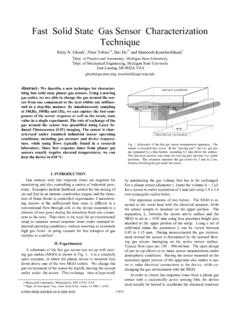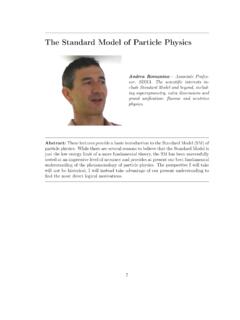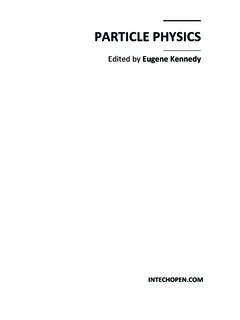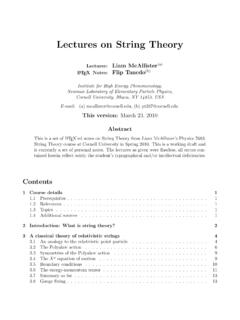Transcription of Introduction to Scattering Theory - Michigan State University
1 Phys 852, Quantum mechanics II, Spring 2008 Introduction to Scattering TheoryStatement of the problem: Scattering Theory is essentially time-independent perturbation Theory applied to the case of a continuousspectrum. That means that we know there is an eigenstate of the full Hamiltonian for every possible energy,E. Thus the job of finding the full eigenvalues, which was a major part of TIPR, is not necessary Scattering Theory , we just pick anyE, and then try to find the perturbed eigenstate,| (E)i. On theother hand, remember that there are usually multiple degenerate eigenstates for any given energy. Sothe question becomes; which of the presumably infinitely many degenerate full-eigenstates are we tryingto compute? The answer comes from causality; we want to be able to completely specify the probabilitycurrent amplitude cominginfrom~r= , and then we want the Theory to give us the correspondingoutgoing current amplitude. The way we do this is to pick an unperturbed eigenstate which has thedesired incoming current amplitude (we don t need to worry what the outgoing current amplitude ofthe unperturbed State is).
2 The second step is to make sure that our perturbation Theory generates noadditional incoming currents, which we accomplish by putting this condition in by hand, under the mantraof causality . As we will see, this means that the resulting full eigenstate will have the desired incomingcurrent amplitude. Now if you go back to what you know, you will recall that solving a partial differentialequation requires first specifying the desired boundary conditions, which is exactly what the standardscattering Theory formalism is designed to , the Scattering formalism is described in the following way: an incident particle in State | 0iis scattered by the potentialV, resulting in a scattered State | si. The incident State | 0iis assumed to bean eigenstate of the background hamiltonianH0, with eigenvalueE. This is expressed mathematically as(E H0)| 0i= 0.(1)Unless otherwise specified, the background Hamiltonian should be taken as that of a free-particle,H0=P22M,(2)and the incident State taken as a plane waveh~r| 0i= 0(~r) =ei~k ~r.
3 (3)As with one-dimensional Scattering , we do not need to worry about the normalization of the incident , the potentialV(~R) is assumed to be localized , so thatlimr V(~r) = 0.(4)The goal of Scattering Theory is then to solve the full energy-eigenstate problem(E H0 V)| i= 0,(5)whereE >0 (unless otherwise specified), and| iis the eigenstate of the full HamiltonianH=H0+Vwith energyE. It should be clear that there is a different| 0iand correspondingly, a different| ifor eachenergyE, even though our notation does not indicate this Green s function The Lippman-Schwinger start by defining the scattered State ,| sivia| si=| i | 0i.(6)The full Scr odinger equation (5) can be written as(E H0)| i=V| i,(7)which after substituting| i=| 0i+| si, and making use of (1) gives(E H0)| si=V| i.(8)Operating on both sides with (E H0) 1leads to| si= (E H0) 1V| i,(9)which, by adding| 0ito both sides, becomes| i=| 0i+ (E H0) 1V| i.(10)This is known as the Lippman-Schwinger The Green s functionIt is often expressed in a slightly more compact notation by introducing the concept of a Green s function ,defined asGH(E) = lim 0(E H0+i ) 1.
4 (11)Thei term is is added by hand to enforce causality by making sure that| sihas no incoming probabilitycurrent associated with it. It makes sense that scattered waves propagate away from the source, and notthe other way around. For simplicity, we can use the symbolG0for the unperturbed Green s function,defined asG0=GH0(E) = lim 0(E H0+i ) 1.(12)Using this definition, the Lippman-Schwinger equation assumes its standard form:| i=| 0i+G0V| i.(13)Solving the Lippman-Schwinger equation for| iis formally very simple, giving| i= (1 G0V) 1| 0i.(14)We will look at the meaning of this solution in the next The Born SeriesAnother way to solve the Lippman-Schwinger equation is by the iteration method. To solve (13) byiteration, we first rewrite the equation as| newi=| 0i+G0V| oldi.(15)We then start with the zerothorder approximation,| oldi=| 0i, and use (15) to generate a betterapproximation,| newi= (1+G0V)| 0i. Using this as| oldithen leads to a better approximation,| newi=(1 +G0V+G0V G0V)| 0i.
5 After an infinite number of iterations, this procedure leads to| i= (1 +G0V+G0V GV+G0V G0V G0V+..)| 0i,(16)which is known as the Born series. Written as an integral equation, the Born-series for the wavefunction, (~r) =h~r| i, looks like (~r) = 0(~r) +ZdV G0(~r,~r )V(~r ) 0(~r ) +ZdV dV G0(~r,~r )V(~r )G0(~r ,~r )V(~r ) 0(~r ) +..,(17)where we have defined 0(~r) =h~r| 0iandG0(~r,~r ) =h~r|G0|~r i. We can interpret this result by reading each term from right-to-left, as follows: If we put a detector at position~r, then the probability that thedetector would fire after the collision is over is proportional to| (~r)|2. The first term on the is thusthe probability amplitude that the particle made it to the detector without Scattering (what it would beifV= 0). The second terms describes the particle Scattering once, at a point~r , where its amplitude isincreased/decreased by a factorV(~r ), and then propagating as a free-spherical wave centered at~r to thedetector.
6 The integral over all~r then sums over all possible collision locations. The next terms describesthe particle Scattering twice, summing over both collisionlocations. The third term would include allpossible paths with three collisions, and so-on. Thus we seethat the total amplitude is the sum overall possible trajectories by which the particle could have made it to the detector, assuming straight-linepropagation between point-contact collisions. From this interpretation, we can guess that the Green sfunction would have the form:G0(~r,~r ) =eik|~r ~r ||~r ~r| ,(18)as theeik|~r ~r |factor just adjusts the phase of the State to reflect propagation with wavelength = 2 /k,over a distanced=|~r ~r |, while the 1/|~r ~r |factor lead to a probability density which decreases as 1/d2,consistent with conservation of probability on an expanding spherical phase front. As we will see, asidefrom an overall constant, this is the correct three-dimensional Green s quantum picture of Scattering , as suggested by the Born series, is of free propagation (described byG0) punctuated by instantaneous collisions , described byV.
7 This picture is at odds with the classicalpicture of a smooth continuous motion on the potential surface . Indeed, in high-energy physics , welearn that all interactions are due to the exchange of virtual (non-energy conserving) gauge bosons, or gluons. The notion of an inter-particle potential is therefore an approximation that neglectsthe retardation effect due to the finite propagation velocityof the mediating particle. This the quantumpicture suggested by the Born series is more accurate than the classical view, as we can think of each collision as the exchange of a virtual particle, which is indeed a discrete Does the Born-series always converge?The iteration method we used to derive the Born-series is just a more compact equivalent formulation ofstandard perturbation Theory . In other words, you would getthe same result if you letV V, and3expanded| i=| 0i+ | 1i+ 2| 2i+.., and so on. Historically, the Scattering problem was solvedperturbatively, where it was soon found that the series did not always converge.
8 Instead the sum woulddiverge towards infinity as more and more terms were included. This was the famous renormalization problem. It was then proposed that a particular infinity could be subtracted, leading to the correct goal of the renormalization program is to add a small correction to each term in the Born series,so that when summing the whole series, the sum of the corrections gives an infinity that exactly cancelsthe infinity in the pure Born series. To see how this works, we can start by defining the eigenstates of(1 G0V) 1according toG0V|zni=zn|zni,(19)whereznis the nthcomplex eigenvalue. We assume a discrete spectrum for convenience, as the argumentwill also hold for a continuous spectrum. In this basis, we can express the operatorG0 VasG0V=Xn|znihzn|1 zn.(20)Note that the series expansion (1 z) 1only converges for|z|<1. This is because a series expansionconverges only as far from the expansion point as the nearestsingularity in the function being the expansion point isz= 0 and the singularity is atz= 1.
9 We can perform a valid series expansionof (1 G0V) 1via(1 G0V) 1=Xnu(1 |zn|)|znihzn| 1 +zn+z2n+.. +Xnu(|zn| 1)|znihzn|1 zn,(21)whereu(x) is the unit step function. For the case|zn|>1, we can expand in powers of 1/zn, as11 zn= 1zn11 1zn= 1zn 1 +z 1n+z 2n+..(22)These two series can be combined to give(1 G0V) 1=Xn|znihzn| Xm=0 zmn+u(|zn| 1) zmn+ z m 1n = Xm=0Xn|znihzn| zmn u(|zn| 1) zmn+z m 1n = Xm=0[(G0V)m Rm](23)where themthrenormalization term isRm=Xnu(|zn| 1)|znihzn| zmn+z m 1n .(24)The idea is then that the renormalized series will converge normally, so you can take only as many termsas required for precision. Of course this renormalization is difficult in practice because the eigenvalues andeigenvectors ofG0 Vare not usually known, but it establishes the proof-of-principle of the renormalized Born The T-MatrixFrom the Born-series, we see that the scattered wave| si=| i | 0iis given by| si= (G0V+G0V G0+G0V G0V G0V+..)| 0i.(25)Based on our path-integral interpretation, we see that eachterm contains at least one Scattering event.
10 For each term, the scattered wave then propagated freely from the last Scattering point to the final free-propagation can be factored out giving| si=G0(V+V G0V+V G0V G0V+..)| 0i.(26)Then the sum inside parentheses is just the story of all the possible ways the particle could have made it tothe location of the final Scattering event. If we put all of this story in a black box , and call it a T-matrix,we get| si=G0T| 0i,(27)which defines the T-matrix. Comparison with (9) and (14) shows that| si=G0V(1 G0V) 1| 0i(28)from which we see immediately thatT=V(1 G0V) 1,(29)or equivalentlyT= (1 V G0) 1V.(30)This equivalence can be proven by hitting both equations from the left with (1 V G0) and from the rightwith (1 G0V), which givesV+V G0V=V+V the issue of convergence for a moment, the series expansion (1 A) 1= 1+A+A2+.., givesT=V+V G0V+V G0V G0V+V G0V G0V G0V+..(31)Projecting this onto position eigenstates results in the position-space matrix elements of the T-matrix:T(~r,~r ) =V(~r) (~r ~r ) +V(~r)G(~r ,~r )V(~r ) +ZdV V(~r)G(~r ,~r )V(~r )G(~r ,~r )V(~r ) +.
















